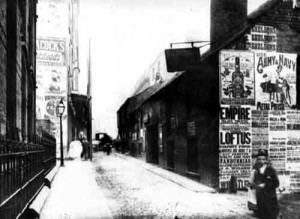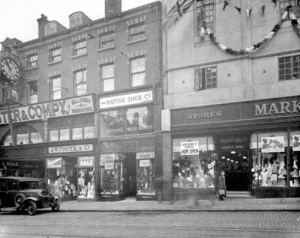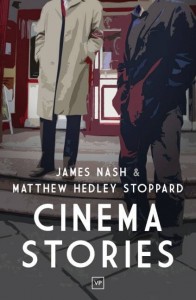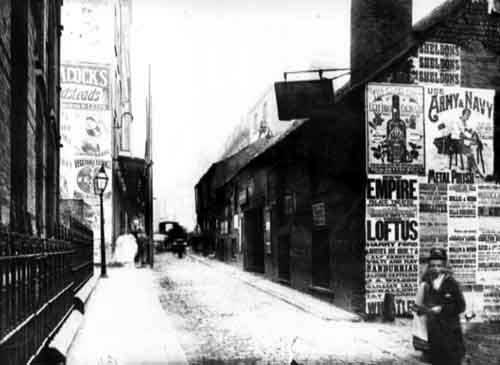You may know about Louis Le Prince’s Leeds connection and his invention of the moving picture here in Leeds. This month Chris Nickson tells us what happened next for cinema in Leeds after that technological break through.
It’s hardly a secret that the moving picture was invented in Leeds by Louis Le Prince. There’s a blue plaque at the south end of Leeds Bridge to commemorate the event in 1888, and a little of that pioneering footage remains.
https://www.youtube.com/watch?v=0CtMXpVLxWs
In the end, Le Prince never received his credit. But the fact of moving pictures became a sensation, the modern entertainment of the last decade of the 19th century and the start of the 20th. Leeds certainly wasn’t immune. The range of subjects that made it to the screen, and the places where they were shown, indicated that the public couldn’t get enough of this novelty.
“Roll up, roll up, ladies and gentlemen! See two thousand, seven hundred and sixty pictures a minute pass before your naked eye! Real moving pictures at five scenes for a shilling!”
That was what the doorman outside the shop at 76 Briggate began to shout in February 1895. The place had once been a pork butcher but it had been converted into what was essentially the first cinema in Leeds, Issott’s Kinetoscope Parlour. The five scenes were five short films shot at the studios of Thomas Edison in America (unsurprisingly, Edison had invented the Kinetoscope; in a rare business lapse, he forgot to patent it outside the US).
The entry fee was the equivalent of £5 today. The business took in about £30 a day (a little over £3,000 in current terms) for several months, at least until the novelty waned. Among the ‘scenes’ were The Barbershop and Disturbance in a Public Bar. Unfortunately, the supply of films was short, and the Kinetoscope itself had large batteries that had to be charged often.
https://youtu.be/LQmngipSo5U
Move ahead to 1897, and some of the same scenes were being shown at the Theatre Royal on Lands Lane, and a little later equipment known as a Cinematograph showed moving pictures at Holbeck Feast.

The man behind the second venture came from Drighlington. His name was Harry Ashington, and as well as the film show, he also ran the marionette booth. But the seating and cinematograph were housed in what he called Ashington’s Portable Pavilion which was hauled around by a steam engine name Yorkshire Bob.
These were the early days, of course, when any moving picture would draw a crowd. They persisted for a while, popping up here and there with a few films, then moving on again. But 76 Briggate seemed to be the first proper home of the moving picture in Leeds. And for about a year in 1908 it hosted the first immersive movie experience, a kind of forerunner of the IMAX.
Inside, the shop was fitted out as an observation car on the American railway, and the films were screened against a wall that represented the open end of the carriage. And the films themselves? They were shot on cameras attached to the front of a locomotive, so there was a constant sense of movement. Each showing was a journey, although some were more urban than others.
Invented by an American named George C Hale, they were marketed as Hale’s Tours of the World, and proved very successful for a time. To complete the illusion, guards went around and sold sixpenny return tickets during each showing, according to G.J. Mellor in Movie Makers and Picture Palaces.
But cinemas as we know them today had begun, built specifically for the new entertainment. It was a fledgling industry (and one in which Leeds would play a part). 76 Briggate left behind its glamour and became…Marks & Spencer Penny Bazaar.

 If you are interested in more cinema stories, then Headingley Lit Fest is hosting a free event at Headingley Library with poets Matthew Hedley Stoppard and James Nash on Tuesday 15th March.
If you are interested in more cinema stories, then Headingley Lit Fest is hosting a free event at Headingley Library with poets Matthew Hedley Stoppard and James Nash on Tuesday 15th March.
Since 2014, poets James Nash and Matthew Hedley Stoppard have been visiting the sites of legendary Leeds picture-houses, and documenting their current status with two inimitable, unmistakable poetic voices – whilst also considering the remarkable shared (yet personal) experience that is cinema-going.
Cinema Stories is published by Valley Press.
 We are delighted to be hosting an exclusive preview of Chris Nickson’s first play, The Empress on the Corner, at the Leeds Big Bookend Festival 2016.
We are delighted to be hosting an exclusive preview of Chris Nickson’s first play, The Empress on the Corner, at the Leeds Big Bookend Festival 2016.
Annabelle Harper features in the Inspector Tom Harper mysteries set in the 1890s – Gods of Gold, Two Bronze Pennies, Skin Like Silver – written by Chris Nickson, in addition to several short stories. In this one-woman play, featuring Carolyn Eden as Annabelle, she tells her story. Growing up on the Bank, the poorest part of the city, the hopeless life of mills or maids for the girls there. The circumstances that made her landlady of the Victoria public house in Sheepscar, also running three bakeries and becoming the Empress on the Corner. Then her political awakening, speaking out, speaking loud, the determination to see that her own daughter has more but she never forgets how life remains for so many.
A one-woman play starring Carolyn Eden, written by Chris Nickson, Saturday June 4, Leeds Central Library, 2.30 pm, as part of Leeds Big Bookend Festival 2016. There will be a Q&A afterwards with Chris, Carolyn and the play’s Director.
Tickets £5 + VAT. Click here.


